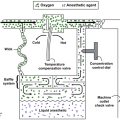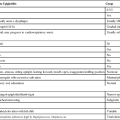Intraoperative wheezing: Etiology and treatment
Wheezing or rhonchi, lung sounds detected by auscultation, are produced when gas flows through a narrowed or obstructed upper or lower airway. The lung sounds are caused by turbulence or resistance to flow. The obstruction can be extrinsic to the airway, intrinsic (within the airway wall), or within the lumen (Box 154-1). For a patient who is intubated and ventilated, an increase in peak airway pressure, a decrease in tidal volume, or a decrease in the slope of the expiratory CO2 curve may indicate airway narrowing or increased airway resistance. Persistent and severe airway obstruction may be followed by O2 desaturation, hypercapnia, and hypotension secondary to increased intrathoracic pressure. Most (80%) of the resistance to flow in airways occurs in the large central airways, leaving 20% of airway resistance from the peripheral bronchioles. Thus, large changes in the caliber of small airways may result in small changes in resistance, making the small airways a clinically silent area. In the American Society of Anesthesiologists closed claims analysis, respiratory events that lead to death or permanent brain damage, 56 (11%) were associated with bronchospasm.




